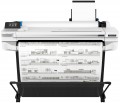Placement
-
Floor. Plotters designed for installation directly on the floor, on special stands; the availability of a stand for such a device is mandatory, because it carries various auxiliary equipment – particularly, a basket for completed prints. The floor models are predominantly advanced models, which are distinguished by their large weight and size. This option is convenient because the plotter does not require additional surfaces such as tables for installation. On the other hand, such a unit can create inconvenience in tight room where there is little free space on the floor. Also note that some floor models are not equipped with stands, they must be purchased separately.
-
Desktop. Plotters designed to be placed on a table, workbench, or other similar stand. This installation is good in constrained conditions, because it does not require floor space. On the other hand, it imposes some restrictions on weight and dimensions, which is why desktop plotters are usually designed for relatively small paper sizes - A2, less often A1 (see above).
Print speed
The print speed provided by the plotter.
Such devices are intended for large-format material, so this parameter is usually indicated as m² per hour. Keep in mind that the spec usually give the maximum print speed, which is achieved at a reduced resolution and overall quality; in standard mode, the plotter may work noticeably slower. So when choosing for this parameter, it is worth taking a certain margin. On the other hand, according to the values indicated in the specs, it is quite possible to evaluate different models and compare them with each other: the difference in the claimed performance, usually, will proportionally correspond to the difference in the actual speed of work.
As for specific values, speed
up to 20 m²/h for modern plotters is considered low,
21 – 50 m²/h — medium, and in the most powerful and performant equipment this value can
exceed 50 m²/h.
Drop volume
The smallest drop volume of ink that can be produced by the printhead of an inkjet or similar plotter (see "Product Type").
This parameter is directly related to the print resolution (see “Maximum resolution”): the more dots per inch, the smaller the separate dots and, accordingly, the drops should be. At the same time, models with the same dpi number may differ slightly in this parameter. In such cases, it should be assumed that a smaller droplet volume potentially provides better print quality, with more accurate reproduction of fine lines and borders between individual areas of the image, however, such features accordingly affect the price of the device.
Cartridge model
Models of cartridges used in the plotter. With this info, you can easily find original consumables for the device.
Main unit dimensions (WxDxH)
Dimensions of the main unit of the device. For desktop models (see "Placement") this is the total size of the entire plotter, it is a spec you need to focus on while choosing a model and evaluating a place for installation. For floor-standing devices, the dimensions are indicated here without taking into account the stand, so this parameter plays a minor role and can be useful mainly for storing or transporting the device in disassembled form.
Weight
The total weight of the plotter is usually listed without ink and paper. You should pay attention to this parameter foremost when choosing desktop models (see "Placement"): modern plotters are quite massive, which puts forward corresponding requirements for stands for them.

